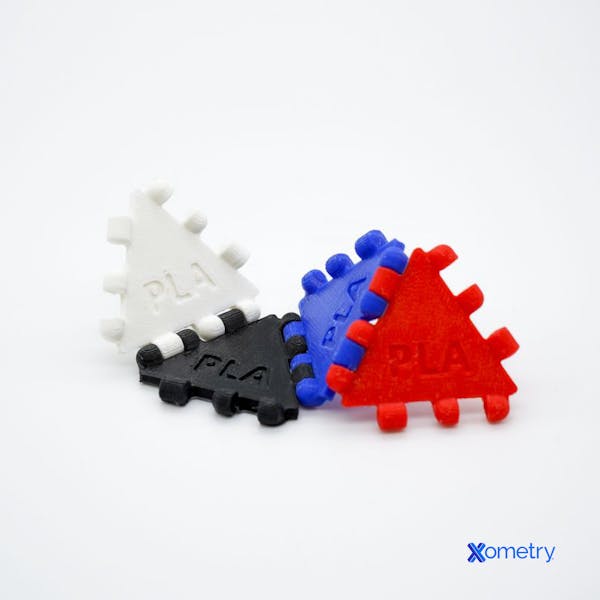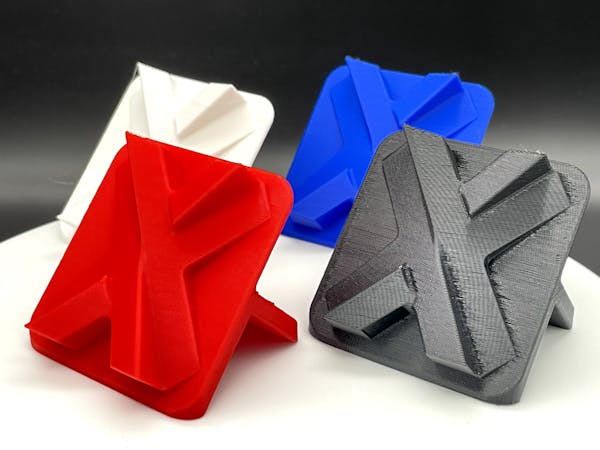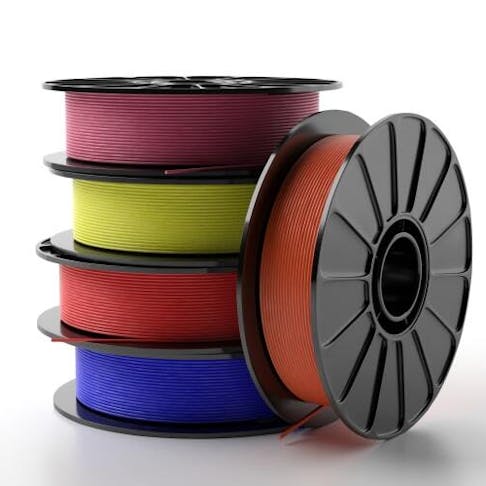PLA (Polylactic Acid) is a bioplastic that is produced from plant starches using a sustainable process. The synthesis of PLA is most commonly done via ring-opening polymerization. PLA is biodegradable under appropriate conditions and is generally regarded as food safe since it decomposes back into its lactic acid building blocks, which are non-toxic.
PLA is widely used in medical devices, food packaging, injection molding, and additive manufacturing (3D printing) applications. PLA can be divided into three different main sub-families, namely: PDLLA (poly DL-lactic acid), PLLA (poly(L-lactic acid), and PDLA (poly(D-lactic acid)). These three sub-groups of PLA have the same chemical makeup but differ in their 3-dimensional molecular structure.
This article will describe what PLA is, its applications, its mechanical properties, and its advantages and disadvantages.
What is PLA (Polylactic Acid)?
PLA is an opaque plastic suitable for making medical components as well as for prototyping applications. PLA is a high-strength but brittle plastic that cannot be used in applications that experience shock loads. The lactic acid building blocks of PLA can be made from fermented plant starch, like corn, under controlled conditions. It takes less energy to produce PLA than petroleum-based thermoplastics, making it relatively eco-friendly. PLA is often regarded as being biodegradable. However, it must be noted that PLA does not degrade naturally in the environment and must be composted under a special set of conditions such as a temperature of at least 60 °C, and humidity of 90 % which must be maintained over a period of 60 to 90 days. PLA decomposes into carbon dioxide, lactic acid, and water.

What Is PLA Made From?
Polylactic acid (PLA) is a bioplastic made from repeating monomers having the chemical formula C3H4O2. Chemically, PLA is made from lactic acid molecules. The lactic acid is fermented from plant matter under precisely controlled conditions. The lactide dimer is produced by dehydrating lactic acid and then thermally degrading the lactic acid oligomers. The lactide is then polymerized using ring-opening polymerization in the presence of a catalyst.
The PLA polymer is produced by making use of either ring-opening polymerization or condensation polymerization, which are two of the most popular synthesis techniques. The condensation polymerization method produces a lower molecular weight form of PLA than the ring-opening polymerization process. This ability to produce a higher molecular weight PLA makes ring-opening polymerization the preferred method of producing PLA.
What Are the Applications of PLA?
Polylactic acid (PLA) is an easy-to-process, biocompatible, biodegradable plastic. As such, it is used for medical implants like stents and implantable drug dispensers that are designed to biodegrade over time. PLA is also used in food packaging and disposable cutlery and can be formed into fibers for clothing. Due to its low melt temperature and ease of use, it is also one of the most widely used 3D printing filaments for fused deposition modeling (FDM).
What Are the Properties of PLA?
The properties of polylactic acid (PLA) are listed in Table 1 below:
| Property | Value |
|---|---|
Property Density (g/cm3) | Value 1.27 |
Property Tensile Strength (MPa) | Value 59 |
Property Elongation @ Break (%) | Value 7 |
Property Elastic Modulus (MPa) | Value 3500 |
Property Shear Modulus (MPa) | Value 1287 |
Property Flexural Strength (MPa) | Value 106 |
Property Rockwell Hardness (HRA) | Value 88 |
Property Glass Transition Temperature (°C) | Value 55 |
Property PLA Melting Point (°C) | Value 165 |
Table Credit: dspace.mit.edu

What Are the Advantages of PLA?
Some of the advantages of PLA plastic are listed below:
- Biocompatibility: PLA is non-toxic to humans. It can remain in contact with the skin for long periods without any negative effects. The decomposition products of PLA are also non-toxic: it degrades into harmless lactic acid. It is often used for stents and sutures that are designed to break down inside the body over several months.
- Low-Energy for Production: PLA takes less energy to produce compared to other petroleum-based plastics due to its relatively low melting point of 165 °C. The polymerization of PLA also consumes 25 to 55 % less energy than other conventional petroleum-based polymers.
- Mechanical Properties: PLA has good room temperature strength and stiffness, but is not suitable for sudden impact loads.
- Food Safe: PLA is non-toxic and is generally recognized as safe by the FDA (Food and Drug Administration).
- Compostable: While PLA is theoretically compostable it must be processed under special temperature and pressure conditions that are only available at some composting facilities.
What Are the Disadvantages of PLA?
Some of the disadvantages of polylactic acid (PLA) plastic are listed below:
- Hydrophobic Material: While hydrophobicity may be a beneficial property in some applications, it can produce negative in vivo effects such as localized swelling.
- Low Thermal Resistance: While its low melting temperature makes it easier to process, PLA cannot be used in applications above 50 °C because of its low glass transition temperature of 55 °C.
- Low Toughness: PLA is a brittle material that tends to break rather than bend, and cannot withstand impact loading.
- High Permeability: PLA is permeable to both gases and waters, which will pass right through the material.
What Are the Different Types of PLA?
There are many different types of PLA plastic that differ in how the chemical chains are structured in 3-dimensional space. These different forms are referred to as stereoisomers. The common stereoisomers of PLA are shown in Table 2:
| Types of PLA | Definition | Differences/ Uses |
|---|---|---|
Types of PLA PDLA (Poly-D-Lactic Acid) | Definition A semi-crystalline plastic produced through the process of ring-opening polymerization of D-lactic acid. | Differences/ Uses Has slower biodegradation rates compared to the other forms of PLA |
Types of PLA PLLA (Poly-L-Lactic Acid) | Definition A semi-crystalline plastic produced through the process of ring-opening polymerization of L-lactic acid | Differences/ Uses A biocompatible material usually used for cosmetic applications as an injectable implant to stimulate collagen formation The most common grade of PLA used in 3D printing and injection molding. PLA+ is often made from PLLA with additional additives to increase strength. |
Types of PLA PDLLA (Poly-DL-lactic Acid) | Definition An amorphous plastic produced through the polymerization of DL-lactide monomers | Differences/ Uses Breaks down in the body relatively quickly, making it an ideal plastic for drug delivery. |
Common FAQs About PLA
Which PLA Is the Strongest?
PDLA and PLLA are both semi-crystalline and therefore have stronger intermolecular bonds when compared to the amorphous PDLLA. As such, the strongest forms of PLA are PDLA and PLLA which have the same properties but just different molecular structures. PLA+ is basically PLLA with some additional proprietary additives that improve the material toughness and is regarded as the strongest form of PLA, especially in 3D printing applications.
Is PLA Compatible With 3D Printing?
Yes, PLA is compatible with 3D printing. In fact, PLA is one of the most commonly used plastics in FDM (Fused Deposition Modeling) due to its ease of use.
How Is PLA Used in 3D Printing?
PLA is used as filament in 3D printing. PLA raw material is formed into a plastic filament with a diameter of either 1.75 or 2.85 mm. This filament is fed into a heated extruder which forces the molten plastic through a nozzle, to build the part up layer by layer. PLA does not require a heated print bed, and its extruder temperature is typically set between 190 and 220 °C. PLA filament is easy to use and has little tendency to warp during the printing process.
What Is the Difference Between PLA and PLA Plus?
PLA Plus or PLA+ is generally tougher than PLA, meaning that it is not as brittle as standard PLA. The exact chemical difference between these two depends on how the various PLA plastic companies define the term PLA+ since there is no formal definition for it. Many different additives are used in standard PLA and then called “PLA Plus.”
Xometry provides a wide range of manufacturing capabilities including CNC machining, 3D printing (including PLA 3D printing), injection molding, laser cutting, and sheet metal fabrication. Get your instant quote today.
Disclaimer
The content appearing on this webpage is for informational purposes only. Xometry makes no representation or warranty of any kind, be it expressed or implied, as to the accuracy, completeness, or validity of the information. Any performance parameters, geometric tolerances, specific design features, quality and types of materials, or processes should not be inferred to represent what will be delivered by third-party suppliers or manufacturers through Xometry’s network. Buyers seeking quotes for parts are responsible for defining the specific requirements for those parts. Please refer to our terms and conditions for more information.

